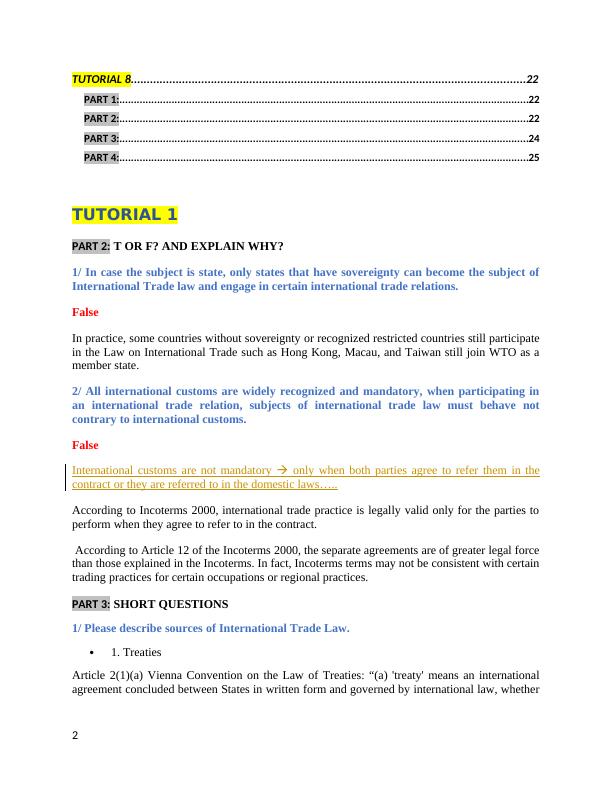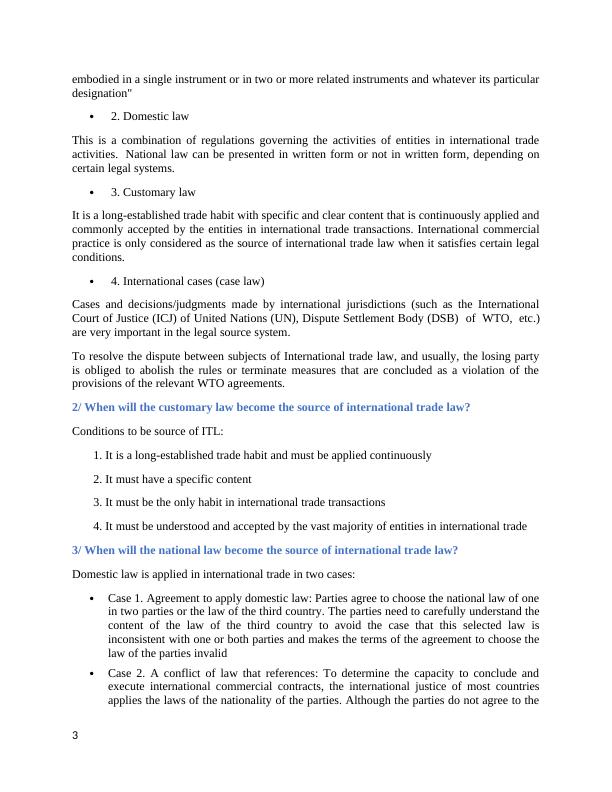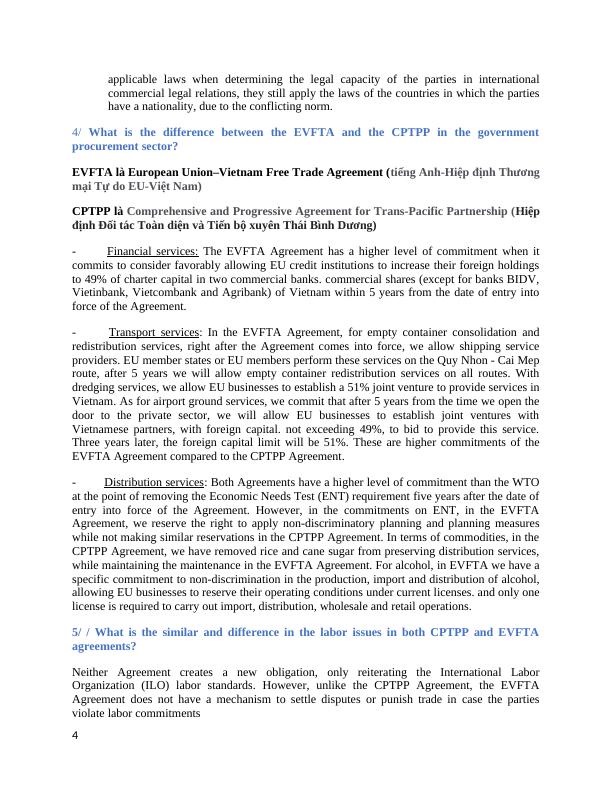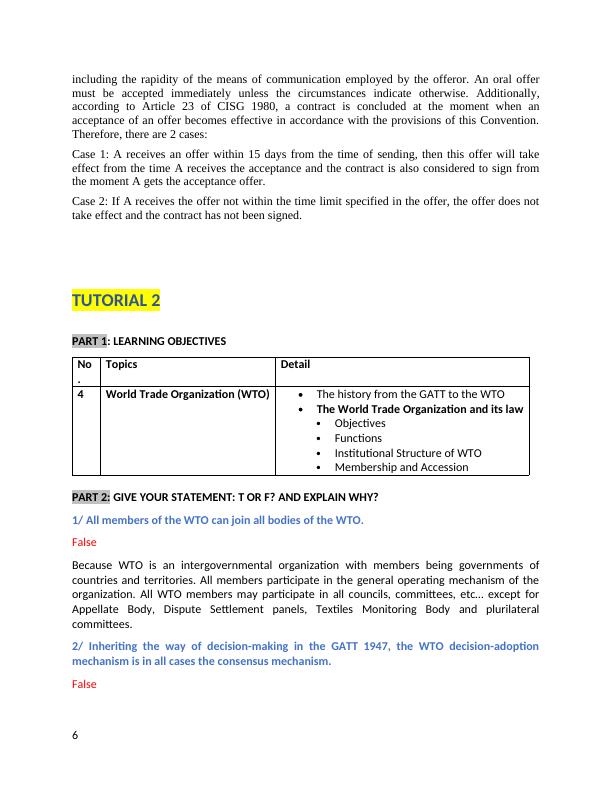International trade Law PDF
28 Pages10143 Words172 Views
Added on 2021-08-20
International trade Law PDF
Added on 2021-08-20
ShareRelated Documents
Table of Contents
TUTORIAL 1.............................................................................................................................2
PART 2:..............................................................................................................................................2
PART 3:..............................................................................................................................................2
PART 4:..............................................................................................................................................4
TUTORIAL 2.............................................................................................................................6
PART 1................................................................................................................................................6
PART 2:..............................................................................................................................................6
TUTORIAL 3.............................................................................................................................7
PART 1:..............................................................................................................................................7
PART 2:..............................................................................................................................................7
PART 3:..............................................................................................................................................7
TUTORIAL 4...........................................................................................................................10
PART 1:.............................................................................................................................................10
PART 2:.............................................................................................................................................10
PART 3:.............................................................................................................................................11
PART 4:.............................................................................................................................................12
TUTORIAL 5...........................................................................................................................12
PART 1:.............................................................................................................................................12
PART 2:.............................................................................................................................................13
PART 3:.............................................................................................................................................14
PART 4:.............................................................................................................................................16
TUTORIAL 6...........................................................................................................................16
PART 1:.............................................................................................................................................16
PART 2:.............................................................................................................................................17
PART 3:.............................................................................................................................................18
PART 4:.............................................................................................................................................18
TUTORIAL 7...........................................................................................................................19
PART 1:.............................................................................................................................................19
PART 2:.............................................................................................................................................20
PART 3:.............................................................................................................................................20
1
TUTORIAL 1.............................................................................................................................2
PART 2:..............................................................................................................................................2
PART 3:..............................................................................................................................................2
PART 4:..............................................................................................................................................4
TUTORIAL 2.............................................................................................................................6
PART 1................................................................................................................................................6
PART 2:..............................................................................................................................................6
TUTORIAL 3.............................................................................................................................7
PART 1:..............................................................................................................................................7
PART 2:..............................................................................................................................................7
PART 3:..............................................................................................................................................7
TUTORIAL 4...........................................................................................................................10
PART 1:.............................................................................................................................................10
PART 2:.............................................................................................................................................10
PART 3:.............................................................................................................................................11
PART 4:.............................................................................................................................................12
TUTORIAL 5...........................................................................................................................12
PART 1:.............................................................................................................................................12
PART 2:.............................................................................................................................................13
PART 3:.............................................................................................................................................14
PART 4:.............................................................................................................................................16
TUTORIAL 6...........................................................................................................................16
PART 1:.............................................................................................................................................16
PART 2:.............................................................................................................................................17
PART 3:.............................................................................................................................................18
PART 4:.............................................................................................................................................18
TUTORIAL 7...........................................................................................................................19
PART 1:.............................................................................................................................................19
PART 2:.............................................................................................................................................20
PART 3:.............................................................................................................................................20
1

TUTORIAL 8...........................................................................................................................22
PART 1:.............................................................................................................................................22
PART 2:.............................................................................................................................................22
PART 3:.............................................................................................................................................24
PART 4:.............................................................................................................................................25
TUTORIAL 1
PART 2: T OR F? AND EXPLAIN WHY?
1/ In case the subject is state, only states that have sovereignty can become the subject of
International Trade law and engage in certain international trade relations.
False
In practice, some countries without sovereignty or recognized restricted countries still participate
in the Law on International Trade such as Hong Kong, Macau, and Taiwan still join WTO as a
member state.
2/ All international customs are widely recognized and mandatory, when participating in
an international trade relation, subjects of international trade law must behave not
contrary to international customs.
False
International customs are not mandatory only when both parties agree to refer them in the
contract or they are referred to in the domestic laws.....
According to Incoterms 2000, international trade practice is legally valid only for the parties to
perform when they agree to refer to in the contract.
According to Article 12 of the Incoterms 2000, the separate agreements are of greater legal force
than those explained in the Incoterms. In fact, Incoterms terms may not be consistent with certain
trading practices for certain occupations or regional practices.
PART 3: SHORT QUESTIONS
1/ Please describe sources of International Trade Law.
1. Treaties
Article 2(1)(a) Vienna Convention on the Law of Treaties: “(a) 'treaty' means an international
agreement concluded between States in written form and governed by international law, whether
2
PART 1:.............................................................................................................................................22
PART 2:.............................................................................................................................................22
PART 3:.............................................................................................................................................24
PART 4:.............................................................................................................................................25
TUTORIAL 1
PART 2: T OR F? AND EXPLAIN WHY?
1/ In case the subject is state, only states that have sovereignty can become the subject of
International Trade law and engage in certain international trade relations.
False
In practice, some countries without sovereignty or recognized restricted countries still participate
in the Law on International Trade such as Hong Kong, Macau, and Taiwan still join WTO as a
member state.
2/ All international customs are widely recognized and mandatory, when participating in
an international trade relation, subjects of international trade law must behave not
contrary to international customs.
False
International customs are not mandatory only when both parties agree to refer them in the
contract or they are referred to in the domestic laws.....
According to Incoterms 2000, international trade practice is legally valid only for the parties to
perform when they agree to refer to in the contract.
According to Article 12 of the Incoterms 2000, the separate agreements are of greater legal force
than those explained in the Incoterms. In fact, Incoterms terms may not be consistent with certain
trading practices for certain occupations or regional practices.
PART 3: SHORT QUESTIONS
1/ Please describe sources of International Trade Law.
1. Treaties
Article 2(1)(a) Vienna Convention on the Law of Treaties: “(a) 'treaty' means an international
agreement concluded between States in written form and governed by international law, whether
2

embodied in a single instrument or in two or more related instruments and whatever its particular
designation"
2. Domestic law
This is a combination of regulations governing the activities of entities in international trade
activities. National law can be presented in written form or not in written form, depending on
certain legal systems.
3. Customary law
It is a long-established trade habit with specific and clear content that is continuously applied and
commonly accepted by the entities in international trade transactions. International commercial
practice is only considered as the source of international trade law when it satisfies certain legal
conditions.
4. International cases (case law)
Cases and decisions/judgments made by international jurisdictions (such as the International
Court of Justice (ICJ) of United Nations (UN), Dispute Settlement Body (DSB) of WTO, etc.)
are very important in the legal source system.
To resolve the dispute between subjects of International trade law, and usually, the losing party
is obliged to abolish the rules or terminate measures that are concluded as a violation of the
provisions of the relevant WTO agreements.
2/ When will the customary law become the source of international trade law?
Conditions to be source of ITL:
1. It is a long-established trade habit and must be applied continuously
2. It must have a specific content
3. It must be the only habit in international trade transactions
4. It must be understood and accepted by the vast majority of entities in international trade
3/ When will the national law become the source of international trade law?
Domestic law is applied in international trade in two cases:
Case 1. Agreement to apply domestic law: Parties agree to choose the national law of one
in two parties or the law of the third country. The parties need to carefully understand the
content of the law of the third country to avoid the case that this selected law is
inconsistent with one or both parties and makes the terms of the agreement to choose the
law of the parties invalid
Case 2. A conflict of law that references: To determine the capacity to conclude and
execute international commercial contracts, the international justice of most countries
applies the laws of the nationality of the parties. Although the parties do not agree to the
3
designation"
2. Domestic law
This is a combination of regulations governing the activities of entities in international trade
activities. National law can be presented in written form or not in written form, depending on
certain legal systems.
3. Customary law
It is a long-established trade habit with specific and clear content that is continuously applied and
commonly accepted by the entities in international trade transactions. International commercial
practice is only considered as the source of international trade law when it satisfies certain legal
conditions.
4. International cases (case law)
Cases and decisions/judgments made by international jurisdictions (such as the International
Court of Justice (ICJ) of United Nations (UN), Dispute Settlement Body (DSB) of WTO, etc.)
are very important in the legal source system.
To resolve the dispute between subjects of International trade law, and usually, the losing party
is obliged to abolish the rules or terminate measures that are concluded as a violation of the
provisions of the relevant WTO agreements.
2/ When will the customary law become the source of international trade law?
Conditions to be source of ITL:
1. It is a long-established trade habit and must be applied continuously
2. It must have a specific content
3. It must be the only habit in international trade transactions
4. It must be understood and accepted by the vast majority of entities in international trade
3/ When will the national law become the source of international trade law?
Domestic law is applied in international trade in two cases:
Case 1. Agreement to apply domestic law: Parties agree to choose the national law of one
in two parties or the law of the third country. The parties need to carefully understand the
content of the law of the third country to avoid the case that this selected law is
inconsistent with one or both parties and makes the terms of the agreement to choose the
law of the parties invalid
Case 2. A conflict of law that references: To determine the capacity to conclude and
execute international commercial contracts, the international justice of most countries
applies the laws of the nationality of the parties. Although the parties do not agree to the
3

applicable laws when determining the legal capacity of the parties in international
commercial legal relations, they still apply the laws of the countries in which the parties
have a nationality, due to the conflicting norm.
4/ What is the difference between the EVFTA and the CPTPP in the government
procurement sector?
EVFTA là European Union–Vietnam Free Trade Agreement (tiếng Anh-Hiệp định Thương
mại Tự do EU-Việt Nam)
CPTPP là Comprehensive and Progressive Agreement for Trans-Pacific Partnership (Hiệp
định Đối tác Toàn diện và Tiến bộ xuyên Thái Bình Dương)
- Financial services: The EVFTA Agreement has a higher level of commitment when it
commits to consider favorably allowing EU credit institutions to increase their foreign holdings
to 49% of charter capital in two commercial banks. commercial shares (except for banks BIDV,
Vietinbank, Vietcombank and Agribank) of Vietnam within 5 years from the date of entry into
force of the Agreement.
- Transport services: In the EVFTA Agreement, for empty container consolidation and
redistribution services, right after the Agreement comes into force, we allow shipping service
providers. EU member states or EU members perform these services on the Quy Nhon - Cai Mep
route, after 5 years we will allow empty container redistribution services on all routes. With
dredging services, we allow EU businesses to establish a 51% joint venture to provide services in
Vietnam. As for airport ground services, we commit that after 5 years from the time we open the
door to the private sector, we will allow EU businesses to establish joint ventures with
Vietnamese partners, with foreign capital. not exceeding 49%, to bid to provide this service.
Three years later, the foreign capital limit will be 51%. These are higher commitments of the
EVFTA Agreement compared to the CPTPP Agreement.
- Distribution services: Both Agreements have a higher level of commitment than the WTO
at the point of removing the Economic Needs Test (ENT) requirement five years after the date of
entry into force of the Agreement. However, in the commitments on ENT, in the EVFTA
Agreement, we reserve the right to apply non-discriminatory planning and planning measures
while not making similar reservations in the CPTPP Agreement. In terms of commodities, in the
CPTPP Agreement, we have removed rice and cane sugar from preserving distribution services,
while maintaining the maintenance in the EVFTA Agreement. For alcohol, in EVFTA we have a
specific commitment to non-discrimination in the production, import and distribution of alcohol,
allowing EU businesses to reserve their operating conditions under current licenses. and only one
license is required to carry out import, distribution, wholesale and retail operations.
5/ / What is the similar and difference in the labor issues in both CPTPP and EVFTA
agreements?
Neither Agreement creates a new obligation, only reiterating the International Labor
Organization (ILO) labor standards. However, unlike the CPTPP Agreement, the EVFTA
Agreement does not have a mechanism to settle disputes or punish trade in case the parties
violate labor commitments
4
commercial legal relations, they still apply the laws of the countries in which the parties
have a nationality, due to the conflicting norm.
4/ What is the difference between the EVFTA and the CPTPP in the government
procurement sector?
EVFTA là European Union–Vietnam Free Trade Agreement (tiếng Anh-Hiệp định Thương
mại Tự do EU-Việt Nam)
CPTPP là Comprehensive and Progressive Agreement for Trans-Pacific Partnership (Hiệp
định Đối tác Toàn diện và Tiến bộ xuyên Thái Bình Dương)
- Financial services: The EVFTA Agreement has a higher level of commitment when it
commits to consider favorably allowing EU credit institutions to increase their foreign holdings
to 49% of charter capital in two commercial banks. commercial shares (except for banks BIDV,
Vietinbank, Vietcombank and Agribank) of Vietnam within 5 years from the date of entry into
force of the Agreement.
- Transport services: In the EVFTA Agreement, for empty container consolidation and
redistribution services, right after the Agreement comes into force, we allow shipping service
providers. EU member states or EU members perform these services on the Quy Nhon - Cai Mep
route, after 5 years we will allow empty container redistribution services on all routes. With
dredging services, we allow EU businesses to establish a 51% joint venture to provide services in
Vietnam. As for airport ground services, we commit that after 5 years from the time we open the
door to the private sector, we will allow EU businesses to establish joint ventures with
Vietnamese partners, with foreign capital. not exceeding 49%, to bid to provide this service.
Three years later, the foreign capital limit will be 51%. These are higher commitments of the
EVFTA Agreement compared to the CPTPP Agreement.
- Distribution services: Both Agreements have a higher level of commitment than the WTO
at the point of removing the Economic Needs Test (ENT) requirement five years after the date of
entry into force of the Agreement. However, in the commitments on ENT, in the EVFTA
Agreement, we reserve the right to apply non-discriminatory planning and planning measures
while not making similar reservations in the CPTPP Agreement. In terms of commodities, in the
CPTPP Agreement, we have removed rice and cane sugar from preserving distribution services,
while maintaining the maintenance in the EVFTA Agreement. For alcohol, in EVFTA we have a
specific commitment to non-discrimination in the production, import and distribution of alcohol,
allowing EU businesses to reserve their operating conditions under current licenses. and only one
license is required to carry out import, distribution, wholesale and retail operations.
5/ / What is the similar and difference in the labor issues in both CPTPP and EVFTA
agreements?
Neither Agreement creates a new obligation, only reiterating the International Labor
Organization (ILO) labor standards. However, unlike the CPTPP Agreement, the EVFTA
Agreement does not have a mechanism to settle disputes or punish trade in case the parties
violate labor commitments
4

PART 4: CASE STUDY
Company A of Vietnam offers to sell some leather bags to Japanese company B. Offers will take
effect within 15 days from the time of sending (March 5, 2021). Receiving this offer on March
10, 2021, Company B sent a reply with the content of accepting the conditions of A offer and
only changing the content of the dispute settlement authority which is the arbitration of the
International Chamber of Commerce (ICC).
If CISG 1980 is applied in this situation, answer the questions:
1. Is B's reply considered an acceptance of the offer?
No. According to Article 19.1 of CISG 1980, a reply to an offer which purports to be an
acceptance but contains additions, limitations or other modifications is a rejection of the offer
and constitutes a counter-offer. In addition, according to Article 19.3 of CISG 1980, additional or
different terms relating, among other things, to the price, payment, quality and quantity of the
goods, place and time of delivery, extent of one party’s liability to the other or the settlement of
disputes are considered to alter the terms of the offer materially.
2. If B's answer is an acceptance of the offer but A received on March 28, 2021, will the
acceptance of the offer be valid?
There are 2 cases:
Case 1: B’s answer cannot become an acceptance.
No. According to Article 18.2 of CISG 1980, an acceptance of an offer becomes effective at the
moment the indication of assent reaches the offeror. An acceptance is not effective if the
indication of assent does not reach the offeror within the time he has fixed or , if no time is
fixed, within a reasonable time, due account being taken of the circumstances of the transaction,
including the rapidity of the means of communication employed by the offeror. An oral offer
must be accepted immediately unless the circumstances indicate otherwise
Case 2: B’s answer can be considered as an acceptance.
Yes, if without delay A orally so informs B or dispatches a notice to that effect. According to
Article 21.1 of CISG 1980, a late acceptance is nevertheless effective as an acceptance if
without delay the offeror orally so informs the offeree or dispatches a notice to that effect .
Or Article 21.2 of CISG 1980, if a letter or other writing containing a late acceptance shows that
it has been sent in such circumstances that if its transmission had been normal it would have
reached the offeror in due time, the late acceptance is effective as an acceptance unless,
without delay, the offeror orally informs the offeree that he considers his offer as having
lapsed or dispatches a notice to that effect.
3. If B's answer is to accept the offer, what date is the contract signed?
According to Article 18.2 of CISG 1980, an acceptance of an offer becomes effective at the
moment the indication of assent reaches the offeror. An acceptance is not effective if the
indication of assent does not reach the offeror within the time he has fixed or, if no time is fixed,
within a reasonable time, due account being taken of the circumstances of the transaction,
5
Company A of Vietnam offers to sell some leather bags to Japanese company B. Offers will take
effect within 15 days from the time of sending (March 5, 2021). Receiving this offer on March
10, 2021, Company B sent a reply with the content of accepting the conditions of A offer and
only changing the content of the dispute settlement authority which is the arbitration of the
International Chamber of Commerce (ICC).
If CISG 1980 is applied in this situation, answer the questions:
1. Is B's reply considered an acceptance of the offer?
No. According to Article 19.1 of CISG 1980, a reply to an offer which purports to be an
acceptance but contains additions, limitations or other modifications is a rejection of the offer
and constitutes a counter-offer. In addition, according to Article 19.3 of CISG 1980, additional or
different terms relating, among other things, to the price, payment, quality and quantity of the
goods, place and time of delivery, extent of one party’s liability to the other or the settlement of
disputes are considered to alter the terms of the offer materially.
2. If B's answer is an acceptance of the offer but A received on March 28, 2021, will the
acceptance of the offer be valid?
There are 2 cases:
Case 1: B’s answer cannot become an acceptance.
No. According to Article 18.2 of CISG 1980, an acceptance of an offer becomes effective at the
moment the indication of assent reaches the offeror. An acceptance is not effective if the
indication of assent does not reach the offeror within the time he has fixed or , if no time is
fixed, within a reasonable time, due account being taken of the circumstances of the transaction,
including the rapidity of the means of communication employed by the offeror. An oral offer
must be accepted immediately unless the circumstances indicate otherwise
Case 2: B’s answer can be considered as an acceptance.
Yes, if without delay A orally so informs B or dispatches a notice to that effect. According to
Article 21.1 of CISG 1980, a late acceptance is nevertheless effective as an acceptance if
without delay the offeror orally so informs the offeree or dispatches a notice to that effect .
Or Article 21.2 of CISG 1980, if a letter or other writing containing a late acceptance shows that
it has been sent in such circumstances that if its transmission had been normal it would have
reached the offeror in due time, the late acceptance is effective as an acceptance unless,
without delay, the offeror orally informs the offeree that he considers his offer as having
lapsed or dispatches a notice to that effect.
3. If B's answer is to accept the offer, what date is the contract signed?
According to Article 18.2 of CISG 1980, an acceptance of an offer becomes effective at the
moment the indication of assent reaches the offeror. An acceptance is not effective if the
indication of assent does not reach the offeror within the time he has fixed or, if no time is fixed,
within a reasonable time, due account being taken of the circumstances of the transaction,
5

including the rapidity of the means of communication employed by the offeror. An oral offer
must be accepted immediately unless the circumstances indicate otherwise. Additionally,
according to Article 23 of CISG 1980, a contract is concluded at the moment when an
acceptance of an offer becomes effective in accordance with the provisions of this Convention.
Therefore, there are 2 cases:
Case 1: A receives an offer within 15 days from the time of sending, then this offer will take
effect from the time A receives the acceptance and the contract is also considered to sign from
the moment A gets the acceptance offer.
Case 2: If A receives the offer not within the time limit specified in the offer, the offer does not
take effect and the contract has not been signed.
TUTORIAL 2
PART 1: LEARNING OBJECTIVES
No
.
Topics Detail
4 World Trade Organization (WTO) The history from the GATT to the WTO
The World Trade Organization and its law
Objectives
Functions
Institutional Structure of WTO
Membership and Accession
PART 2: GIVE YOUR STATEMENT: T OR F? AND EXPLAIN WHY?
1/ All members of the WTO can join all bodies of the WTO.
False
Because WTO is an intergovernmental organization with members being governments of
countries and territories. All members participate in the general operating mechanism of the
organization. All WTO members may participate in all councils, committees, etc... except for
Appellate Body, Dispute Settlement panels, Textiles Monitoring Body and plurilateral
committees.
2/ Inheriting the way of decision-making in the GATT 1947, the WTO decision-adoption
mechanism is in all cases the consensus mechanism.
False
6
must be accepted immediately unless the circumstances indicate otherwise. Additionally,
according to Article 23 of CISG 1980, a contract is concluded at the moment when an
acceptance of an offer becomes effective in accordance with the provisions of this Convention.
Therefore, there are 2 cases:
Case 1: A receives an offer within 15 days from the time of sending, then this offer will take
effect from the time A receives the acceptance and the contract is also considered to sign from
the moment A gets the acceptance offer.
Case 2: If A receives the offer not within the time limit specified in the offer, the offer does not
take effect and the contract has not been signed.
TUTORIAL 2
PART 1: LEARNING OBJECTIVES
No
.
Topics Detail
4 World Trade Organization (WTO) The history from the GATT to the WTO
The World Trade Organization and its law
Objectives
Functions
Institutional Structure of WTO
Membership and Accession
PART 2: GIVE YOUR STATEMENT: T OR F? AND EXPLAIN WHY?
1/ All members of the WTO can join all bodies of the WTO.
False
Because WTO is an intergovernmental organization with members being governments of
countries and territories. All members participate in the general operating mechanism of the
organization. All WTO members may participate in all councils, committees, etc... except for
Appellate Body, Dispute Settlement panels, Textiles Monitoring Body and plurilateral
committees.
2/ Inheriting the way of decision-making in the GATT 1947, the WTO decision-adoption
mechanism is in all cases the consensus mechanism.
False
6

End of preview
Want to access all the pages? Upload your documents or become a member.
Related Documents
The Formation of International Treatieslg...
|15
|2655
|313
Public International Law Assignment Essaylg...
|22
|7049
|76
Impact of Contract Law on Businesslg...
|7
|1735
|52
Relationship between State's Right to Regulate, Fair and Equitable Treatment and Expropriation under ECT Treaty Practicelg...
|9
|1628
|66
BTX3110 | International Trade Lawlg...
|4
|561
|28
The Study of the General Exceptions and Case Studylg...
|42
|17000
|53
